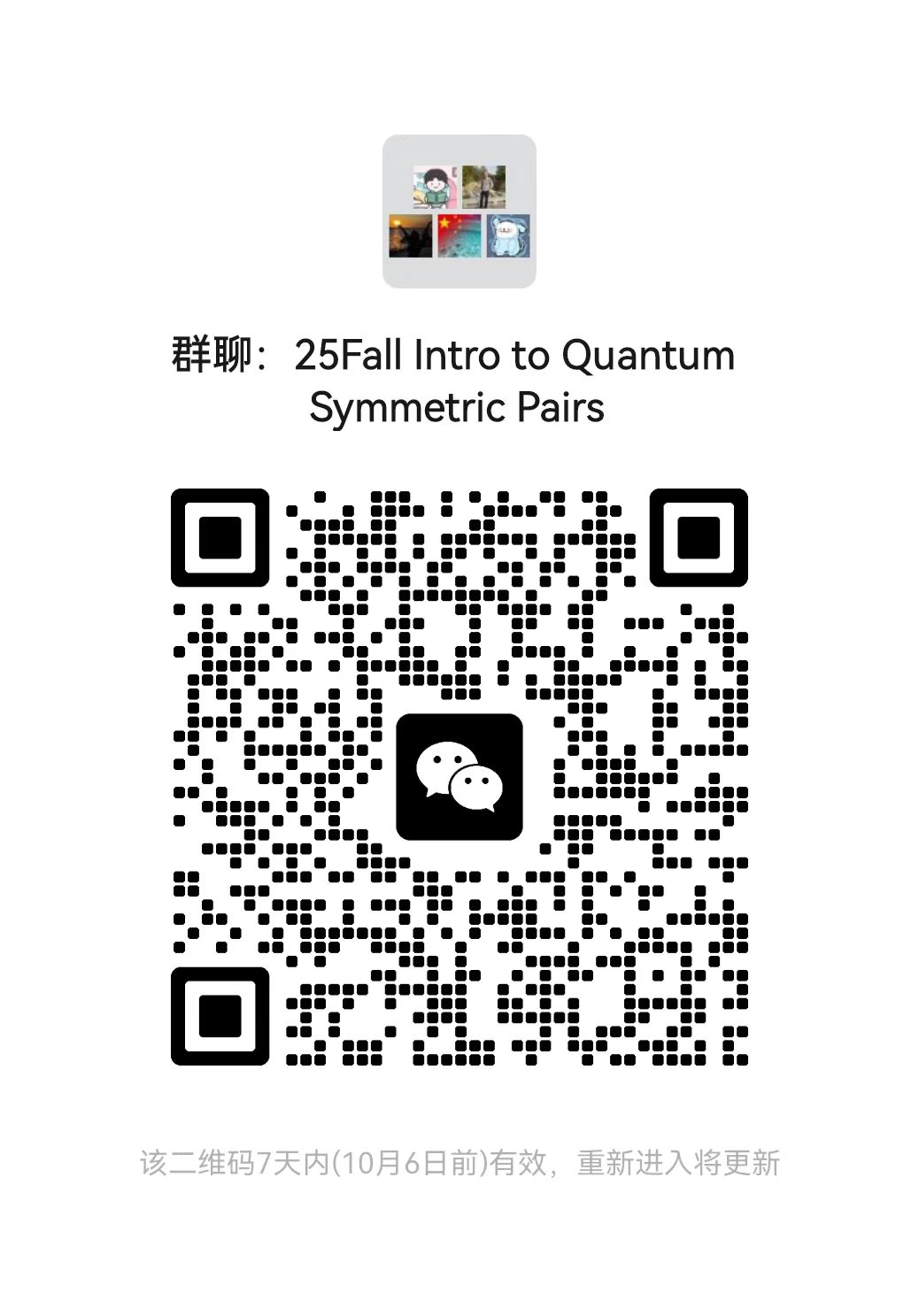Introduction to quantum symmetric pairs
This is a short (18 class hours) course which aims to get researchers acquainted with quantum symmetric pairs, a contemporary topic which has developed in a rapid pace during the last decade.
A Lie algebra $\mathfrak{g}$ together with the fixed-point subalgebra $\mathfrak{g}^\theta$ of an involutive automorphism $\theta$ is called a symmetric pair. For example, let $\mathfrak{g}$ be a matrix Lie algebra and let $\theta$ be "minus the transpose". For a suitable Lie algebra $\mathfrak{g}$ (for example, finite-dimensional simple), its universal enveloping algebra has a deformation $U_q(\mathfrak{g})$ in the class of Hopf algebras (Drinfeld-Jimbo quantum group, quantized enveloping algebra). It has become clear since the 1990s that, if you arrange the involution $\theta$ carefully, then you can define a quantum symmetric pair $(U_q(\mathfrak{g}),U_q'(\mathfrak{g}^\theta))$. The second member is a coideal subalgebra of $U_q(\mathfrak{g})$ also known as $\imath$-quantum group.
We will discuss the basic constructions and their motivations. We will explore some of the representation theory, some applications in mathematical physics and some variations of the construction.
A Lie algebra $\mathfrak{g}$ together with the fixed-point subalgebra $\mathfrak{g}^\theta$ of an involutive automorphism $\theta$ is called a symmetric pair. For example, let $\mathfrak{g}$ be a matrix Lie algebra and let $\theta$ be "minus the transpose". For a suitable Lie algebra $\mathfrak{g}$ (for example, finite-dimensional simple), its universal enveloping algebra has a deformation $U_q(\mathfrak{g})$ in the class of Hopf algebras (Drinfeld-Jimbo quantum group, quantized enveloping algebra). It has become clear since the 1990s that, if you arrange the involution $\theta$ carefully, then you can define a quantum symmetric pair $(U_q(\mathfrak{g}),U_q'(\mathfrak{g}^\theta))$. The second member is a coideal subalgebra of $U_q(\mathfrak{g})$ also known as $\imath$-quantum group.
We will discuss the basic constructions and their motivations. We will explore some of the representation theory, some applications in mathematical physics and some variations of the construction.

讲师
日期
2025年10月17日 至 11月21日
位置
| Weekday | Time | Venue | Online | ID | Password |
|---|---|---|---|---|---|
| 周五 | 14:20 - 16:55 | A3-1a-205 | ZOOM 04 | 482 240 1589 | BIMSA |
修课要求
Basic courses in algebra, representation theory and Lie theory. Some knowledge of Hopf algebras and quantum groups (quantized universal enveloping algebras) will be useful, but will be reviewed.
课程大纲
We will explore a selection of the following topics, depending on time and interest:
1. Symmetric pairs and symmetric spaces in the finite-dimensional case. Real forms. Satake description.
2. Quantum symmetric pairs in the style of Letzter and other approaches (Gavrilik-Klimyk, Noumi et. al.)
3. Cylinder braiding and canonical bases (K-matrix)
4. Finite-dimensional representation theory: highlights and applications
5. Variations and generalizations (pseudo, super, Kac-Moody)
6. Quantum symmetric pairs of affine type and trigonometric K-matrices.
1. Symmetric pairs and symmetric spaces in the finite-dimensional case. Real forms. Satake description.
2. Quantum symmetric pairs in the style of Letzter and other approaches (Gavrilik-Klimyk, Noumi et. al.)
3. Cylinder braiding and canonical bases (K-matrix)
4. Finite-dimensional representation theory: highlights and applications
5. Variations and generalizations (pseudo, super, Kac-Moody)
6. Quantum symmetric pairs of affine type and trigonometric K-matrices.
参考资料
There is not yet a standard textbook on this contemporary topic. Some survey material can be found in:
Weiqiang Wang, "Quantum symmetric pairs", Proc. Int. Cong. Math., vol. 4 (2022).
Stefan Kolb, "Quantum symmetric Kac-Moody pairs", Adv. Math. 267 (2014).
Andrea Appel and Bart Vlaar, "Boundary transfer matrices arising from quantum symmetric pairs", Indag. Math. (2025).
Weiqiang Wang, "Quantum symmetric pairs", Proc. Int. Cong. Math., vol. 4 (2022).
Stefan Kolb, "Quantum symmetric Kac-Moody pairs", Adv. Math. 267 (2014).
Andrea Appel and Bart Vlaar, "Boundary transfer matrices arising from quantum symmetric pairs", Indag. Math. (2025).
听众
Advanced Undergraduate
, Graduate
, 博士后
, Researcher
视频公开
公开
笔记公开
公开
语言
英文
讲师介绍
Bart Vlaar于2022年9月以副研究员身份全职入职BIMSA。他的研究兴趣包括代数和表示论,以及它们在数学物理上的应用。他在苏格兰格拉斯哥大学获得博士学位,之后先后在阿姆斯特丹大学、诺丁汉大学、约克大学和苏格兰赫瑞瓦特大学任职位,并访问位于波恩的马斯克博朗克数学研究所。




